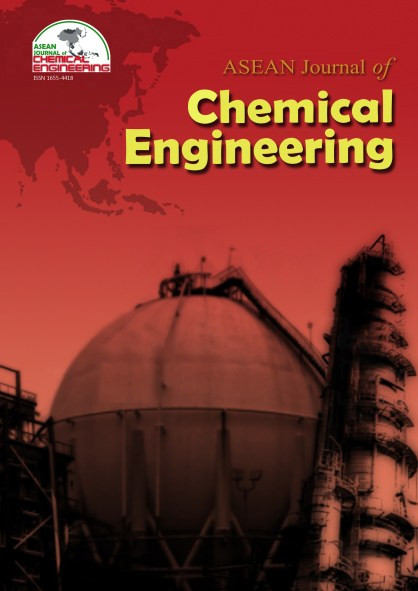Microwave Assisted Glycerolysis Of Neem Oil
Abstract
Biodiesel is considered as a viable alternative to diesel fuels since it is renewable and eco-friendly. Edible oils account for majority of feedstock oils used in biodiesel production since their free fatty acids (FFA) levels are below 1%. However, these oils are expensive and compete with food demand. Low cost feedstock oils may be used but they must undergo a pre-treatment process (glycerolysis) to reduce their FFA content to less than 1%. Conventional glycerolysis requires long reaction times so microwave irradiation is used to speed up the process. Neem oil with an initial %FFA of 1.138% was used to determine the effect of microwave irradiation on different factors that would affect the FFA reduction. The following factors are investigated: reaction time (5 and 9 minutes), reaction temperature (100°C and 120°C), oil to glycerol molar ratio (1:1 and 1:2) and sulfuric acid catalyst concentration or loading (2% and 4.5%). This study reports that reaction temperature was the only significant factor on FFA reduction. A higher temperature resulted in a higher FFA reduction. The optimum factors achieved are: oil to glycerol molar ratio of 1:1, a catalyst loading of 2%, a time of 5.58 minutes and a reaction temperature of 120°C resulting in a 91.81% FFA reductionReferences
2. Anya, A. (2013). Effect of Free Fatty Acid Content on the Yield of Biodiesel Derived from Neem Oil. Journal of Basic and Applied Chemistry, 3(1), 1-4.
3. Banani, R., Youssef, S., Bezzarga, M., &Abderrabba, M. (2015). Waste frying oil with high levels of free fatty acids as one of the prominent sources of biodiesel production. Journal of Materials and Environmental Science, 6(4), 1178–1185.
4. Felizardo, P., Machado, J., Vergueiro, D., Correia, M. J., Gomes, J. P., &Bordado, J. M. (2011). Study on the glycerolysis reaction of high free fatty acid oils for use as biodiesel feedstock. Fuel Processing Technology, 92(6), 1225-1229.
5. Freedman, B et al. (1984).Variables affecting the yields of fatty esters from transesterified vegetable oils. J of the Am. Oil Chem. Soc.,61(10), 1638-1643.
6. Gole, V. and Gogate, P. (2014). Intensification of glycerolysis reaction of higher free fatty acid containing sustainable feedstock using microwave irradiation. Fuel Proc. Tech. 118, 110-116
7. Kumar, R. (2011). Bioresource Technology Microwave assisted alkali-catalyzed transesterification of Pongamiapinnata seed oil for biodiesel production. Bioresource Technology, 102(11), 6617-6620.
8. Lidstrom, P., Tierney, J., Wathey, B., Westman, J., 2001. Microwave assisted organic synthesis-a review. Tetrahedron 57, 9225–9283
9. Mahajan,S., Konar, S. K., & Boocock, D. G. (2006). Determining the acid number of biodiesel. Journal of the American Oil Chemists Society,83(6), 567-570. doi:10.1007/s11746-006-1241-8
10. Mazubert, A et al. (2014). Bioresource Technology Key role of temperature monitoring in interpretation of microwave effect on transesterification and esterification reactions for biodiesel production. Bioresource Technology, 161, 270-279. Retrieved March 29, 2016.
11. Patil, P. D., Gude, V. G., Camacho, L. M., & Deng, S.(2010). Microwave-Assisted Catalytic Transesterification of Camelina Sativa Oil. Energy & Fuels,24(2), 1298-1304.
12. Patil, P. D., Gude, V. G., Reddy, H. K., Muppaneni, T., & Deng, S. (2012). Biodiesel Production from Waste Cooking Oil Using Sulfuric Acid and Microwave Irradiation Processes. J of Env. Prot.,03(01), 107-113.
13. R. Sims, M. Taylor, J. Saddler, W. Mabee, From 1st to 2nd gen biofuel tech. OECD/IEA Report (2008)
14. Sanford, S., White, J., & Shah, P. (2009). Feedstock and biodiesel characteristics report. Renewable Energy ..., 1–136.
15. Wang, Y. (2012). Solid super acid catalyzed glycerol esterification of free fatty acids in waste cooking oil for biodiesel production. European Journal of Lipid Science and Technology, 315-324.
Copyright holder for articles is ASEAN Journal of Chemical Engineering. Articles published in ASEAN J. Chem. Eng. are distributed under a Creative Commons Attribution-NonCommercial 4.0 International (CC BY-NC 4.0) license.
Authors agree to transfer all copyright rights in and to the above work to the ASEAN Journal of Chemical Engineering Editorial Board so that the Editorial Board shall have the right to publish the work for non-profit use in any media or form. In return, authors retain: (1) all proprietary rights other than copyright; (2) re-use of all or part of the above paper in their other work; (3) right to reproduce or authorize others to reproduce the above paper for authors’ personal use or for company use if the source and the journal copyright notice is indicated, and if the reproduction is not made for the purpose of sale.


